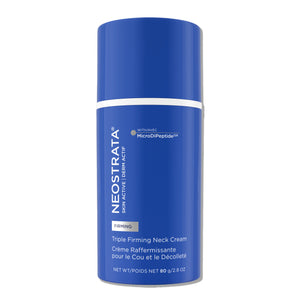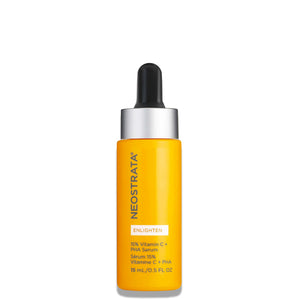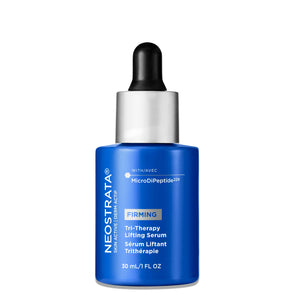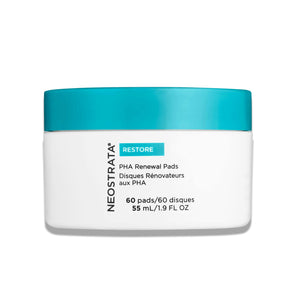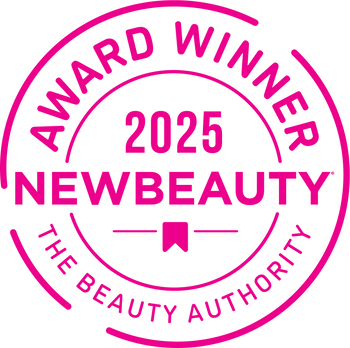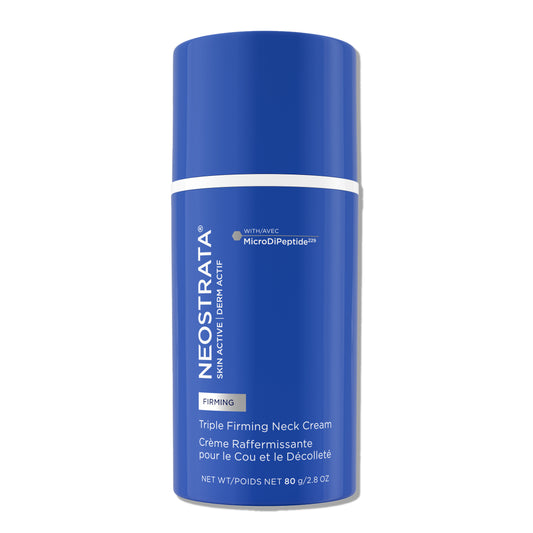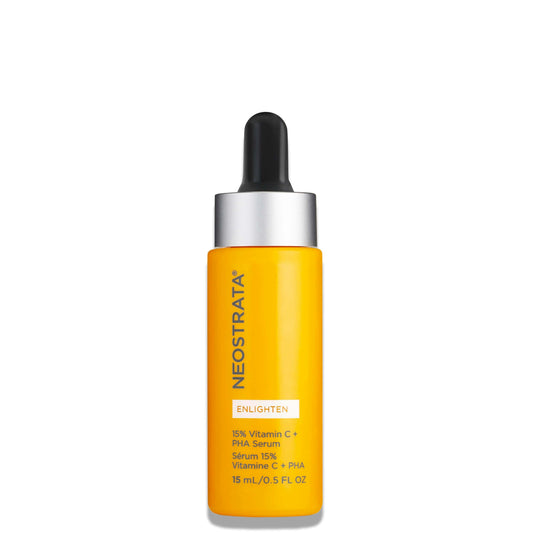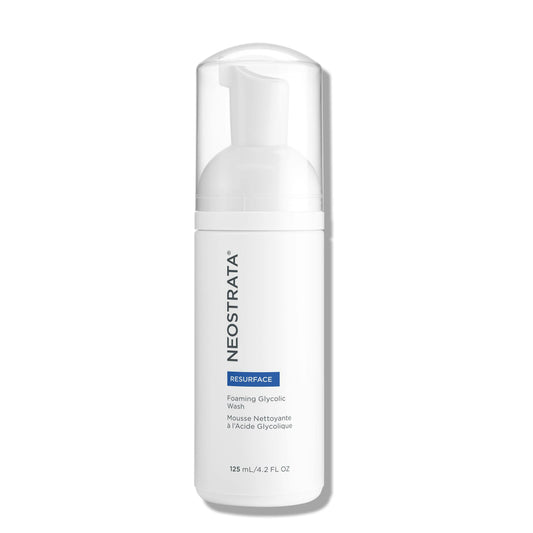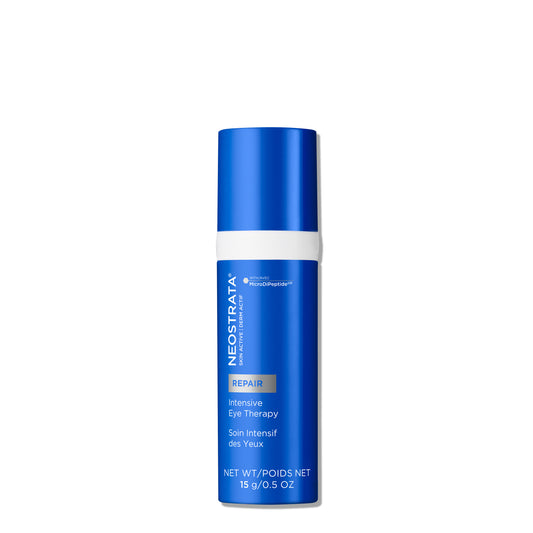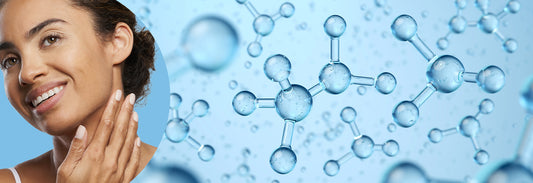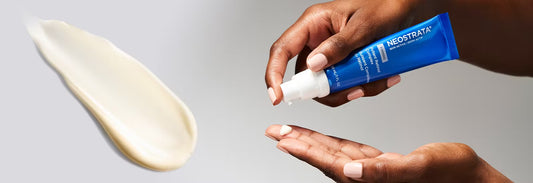Feeling like wrinkles are an inevitable part of aging? The truth is, wrinkles are caused by a combination of factors – most of which are in our control. Normal healthy skin is generally well hydrated, smooth in texture, has an even tone, an intact barrier and abundant collagen and elastin – proteins that help keep skin firm.
As we age, our skin naturally gets thinner, drier, is less elastic, and less able to protect itself from the daily assault of environmental damage. This leads to wrinkles, creases and lines on the skin.
But don’t kid yourself. While genetics and chronological aging cannot be prevented, the physical signs of aging, of which wrinkles are just a part, can be.
Visible Signs of Aging

|
Fine lines and wrinkles |

|
Rough, dry, itchy skin |

|
Slack skin– loss of elastic tissue (elastin and collagen) cause the skin to hang loosely |

|
Uneven pigmentation, dark spots and a mottled appearance |

|
Fragile and transparent– caused by thinning of the epidermis (surface layer of the skin) and dermis (layer of skin under the epidermis) |

|
More easily bruised – caused by thinner blood vessel walls and a thinner, less protective dermal matrix |

|
More prone to developing skin lesions such as precancerous keratoses |
Your Skin Tells the Story of Your Life's Experience
From the time we are born, and throughout our lives, our skin is exposed to a multitude of internal and environmental factors occurring simultaneously. It’s how our body responds to these factors that leads to biological and clinical signs of aging.
Free radicals, produced by an imbalance of oxidative and anti-oxidative processes called oxidative stress, cause aging by damaging skin cells. The more damage they cause, the higher the chance of developing wrinkles and other signs of aging. These free radicals are induced by a number of environmental factors including UV rays, smoking, air pollution, ozone and nutrition.

7 Environmental Factors that Impact Skin Aging:

|
Sun RadationExposure to the sun’s rays is the #1 cause of skin aging via oxidative stress and inflammation. Both UVA rays, which penetrate the skin’s deepest layers, and UVB rays, which cause sunburn, ultimately lead to premature aging and wrinkles. But did you know that photoaging mainly results from daily exposure to low doses of UV radiation, which does not cause visible changes at the time of exposure, but leads to greater biological changes over time. In fact, 80% of facial aging is believed to be due to daily, chronic sun exposure, what is known as incidental sun exposure from everyday activities – walking the dog, retrieving mail, driving in the car, etc. |

|
Air Pollution and OzoneResearchers have found that next to ultraviolet radiation, pollutants like polycyclic aromatic hydrocarbons (chemicals that are released when burning coal, gasoline, trash or tobacco), volatile organic compounds (present in paints, coatings and car exhausts), oxides, particulate matter, ozone and cigarette smoke cause significant damage to the skin. Pollution also heightens the dangers of free radicals. By inducing oxidative stress, damaging cellular structures and depleting natural antioxidants in the skin, these pollutants can lead to inflammation, hyperpigmentation (dark spots), loss of collagen, dehydration and increased sensitivity of the skin. |

|
Tobacco SmokeNeed another reason to quit? Smoking increases free radicals in the skin, speeding up the normal aging process causing facial wrinkling, particularly around the mouth, upper lip and eyes.Nicotine in cigarettes causes narrowing of the blood vessels, impairing blood flow in the outermost layers of the skin. With less blood flow, your skin doesn’t get as much oxygen and important nutrients, such as vitamin A, resulting in dry, dull skin. Many of the more than 4,000 chemicals in tobacco smoke also damage collagen and elastin. As a result, skin begins to sag and wrinkle prematurely. Smoking has also been associated with an increased risk for acne, psoriasis and skin cancer. |

|
TemperatureStudies suggest that heat as well as UV radiation may play an important role in premature skin aging. Repetitive and prolonged heat exposure causes protective antioxidant levels in the skin to drop and collagen breakdown that can accelerate the rate of our skin aging.11 Exposure to cold weather causes the skin to become dry and dehydrated, leading to enhanced appearance of surface lines and wrinkles. |


|
NutritionWhat you eat matters – to your body and your skin. Research has shown a diet rich in anti-oxidants may delay aging effects. Higher vitamin C intake has been associated with a lower likelihood of wrinkles, while consuming too much sugar, fat and carbohydrates has been associated with a higher likelihood for a wrinkled appearance. A diet rich in fruits and vegetables is essential for overall body and skin health. |

|
StressStress affects your mind, body and your skin. Research has shown stress can cause wrinkles and chronic stress can contribute to premature aging. The "fight or flight" stress mechanism triggers the production of cortisol, the primary stress hormone, also known to break down collagen in your skin. The more stressed you are, the more cortisol your body produces and the body is unable to keep pace rebuilding elastin and collagen. |

|
SleepSleep is a time for the body to heal, renew and eliminate toxins from the skin. In a recent study, researchers found that those who didn’t sleep well exhibited more signs of skin aging including fine lines, uneven pigmentation and reduced skin elasticity. The researchers also found that those who enjoyed quality sleep recovered more quickly from stressors to the skin such as sun and environmental toxins. |
7 Ways to Reduce Premature Skin Aging
Remember, you have control over 80% of how your skin ages! To help prevent premature skin aging, experts recommend the following tips:

|
Protect your skin from the sun every day. |

|
Don’t smoke.While wrinkles may not disappear entirely, the return of normal blood flow will bring oxygen and nutrients back to skin cells and reduce inflammation. Topical retinoids and antioxidants, such as vitamins C and E will help bring back a healthy complexion. |

|
Eat a healthy, well-balanced diet.Research suggests that a diet of too much sugar or other refined carbohydrates can accelerate aging. Eating a diet rich in antioxidant-rich fruits and vegetables is vital to preventing damage that leads to premature skin aging. |

|
Exercise regularly.Studies show moderate exercise can improve circulation and boost the immune system giving the skin a more-youthful appearance. Physical fitness, meditation, and deep breathing exercises are also great ways to relieve stress. Remember to use sunscreen every day to protect against aging sun exposure when outdoors. |

|
Get your beauty sleep.Experts recommend 7- 9 hours for sleep every night for the average adult. When you’re tired, it shows on your skin. |

|
Cleanse your skin gently.Scrubbing can irritate your skin. Gentle washing with a soap-free cleanser helps to remove pollution, makeup, and other substances without irritating your skin. Be sure to wash makeup off each night to optimize the skin’s nighttime renewal process. |

|
Exfoliate and moisturize daily.Exfoliation is one of the best ways to renew your skin. Serums and moisturizers trap water in the skin, helping to restore the skin barrier and prevent oxidative damage. |

NEOSTRATA® Skin Active
Complete daily skin care to correct visible signs of aging:

|
Cleanser NEOSTRATA® SKIN ACTIVE Exfoliating Wash with Polyhydroxy Acids (PHAs) including Maltobionic Acid known to exfoliate and remove debris from pores, enhancing skin texture and clarity. The foaming formula with a concentrated botanical complex of aloe, chamomile, cucumber and rosemary extracts helps refresh and revitalize. |

|
Serum Applying a serum before moisturizing gives skin an extra boost and adds a layer of protection from the elements NEOSTRATA® SKIN ACTIVE Tri-Therapy Lifting Serum volumizes the look of slack skin with AMINOFIL Amino acid derivative concentrated to target skin’s hydrating matrix for a more lifted appearance. Renews Tone with Gluconolactone, a Polyhydroxy Acid & antioxidant chelator that helps to gently exfoliate and promote a more even skin tone, and hydrates with low molecular weight (LMW) hyaluronic acid |
 |
Moisturizer The best anti-aging moisturizers have a combination of nourishing ingredients that prevent water loss and restore skin hydration.For day: NEOSTRATA® SKIN ACTIVE Cellular Restoration is A powerful combination of peptides, fruit stem cell extract and Glycolic Acid helps to plump skin's appearance and smooth the look of wrinkles. Enhanced with Polyhydroxy Acids (PHAs) and other potent antioxidants to help moisturize and protect against dry skin and the look of aging due to daily environmental stressors. |
 |
For night NEOSTRATA® SKIN ACTIVE Dermal Replenishment deeply hydrating face cream contains skin’s amino acid building blocks and natural sugars called Natural Moisturizing Factor (NMF) to attract water and help strengthen the skin’s moisture barrier. Proprietary Aminofil® works together with Maltobionic Acid and NeoGluscosamine® technology to help provide a firmer appearance and reduce the look of wrinkles. Study results show Dermal Replenishment provides 56% greater protection against a key inflammatory mediator following exposure to 5 environmental stressors (UV, cigarette smoke, ozone, cold, heat/humidity). |

|
Eye Cream NEOSTRATA® SKIN ACTIVE Intensive Eye Therapy uses multiple mechanisms to build and plump the appearance of slack eye skin. Our patented hydrating eye cream with NeoGlucosamine® and rejuvenating peptides enhances the appearance of the supporting matrix for a firmer look. Caffeine and Hyaluronic Acid formula helps deflate puffy eyes appearance, while hydrating the skin. |

|
Sunscreen Everyone should wear sunscreen, every day, all year long. NEOSTRATA® Sheer Physical Protection Sunscreen Broad Spectrum SPF 50 combines potent antioxidants with a Polyhydroxy Acid (PHA) complex to help protect and support skin's moisture barrier against environmental aggressors. Formulated exclusively with mineral sunscreens: Zinc Oxide and Titanium Dioxide with a sheer, invisible tint. |
At NEOSTRATA®, we believe that visible results come from renewing the layers of the skin. We recognize that everyone’s skin is unique and we have created key collections which aim to achieve healthy-looking skin at every life stage.
Learn How to Use Our Products
To see more videos, visit our YouTube Channel
References
- Farage, Miranda & W Miller, Kenneth & Elsner, Peter & Maibach, Howard. (2013). Characteristics of the Aging Skin. Advances in wound care. 2. 5-10. 10.1089/wound.2011.0356.
- Baumann L. Skin ageing and its treatment. J Pathol. 2007;211:241–51.
- Zhang S, Duan E. Fighting against Skin Aging: The Way from Bench to Bedside. Cell Transplant. 2018;27(5):729-738
- Aging and skin care. https://my.clevelandclinic.org/health/articles/10979-aging-and-skin-care
- Krutmann J, Bouloc A, Sore G, Bernard BA, Passeron T. The skin aging exposome. Journal of Dermatological Science. 2017;85:152–161. doi: 10.1016/j.jdermsci.2016.09.015.
- Addor FAS. Beyond photoaging: additional factors involved in the process of skin aging. Clin Cosmet Investig Dermatol. 2018;11:437-443. Published 2018 Sep 20. doi:10.2147/CCID.S177448
- Liguori I, Russo G, Curcio F, et al. Oxidative stress, aging, and diseases. Clin Interv Aging. 2018;13:757-772. Published 2018 Apr 26. doi:10.2147/CIA.S158513
- Drakaki, Eleni & Dessinioti, Clio & VRETTOU ANTONIOU, CHRISTINA. (2014). Air Pollution and the skin. Frontiers of Environmental Science & Engineering in China. 2. 10.3389/fenvs.2014.00011
- Puri, Poonam & Kumar, Shashi & Kathuria, Sushruta & Ramesh, V. (2017). Effects of air pollution on the skin: A review. Indian Journal of Dermatology, Venereology, and Leprolog.
- Quit Smoking – Mayo Clinic. https://www.mayoclinic.org/healthy-lifestyle/quit-smoking/expert-answers/smoking/faq-20058153
- Cho, Soyun et al. Effects of infrared radiation and heat on human skin aging in vivo (2009) Journal of Investigative Dermatology Symposium Proceedings,14 (1), p 15-19.
- Schagen SK, Zampeli VA, Makrantonaki E, Zouboulis CC. Discovering the link between nutrition and skin aging. Dermatoendocrinol. 2012;4(3):298-307.
- Dunn, J. H, & Koo, J. (2013). Psychological Stress and skin aging: A review of possible mechanisms and potential therapies. Dermatology Online Journal, 19(6). Retrieved from https://escholarship.org/uc/item/3j0766hs
- Oyetakin-White P, et al. Does poor sleep quality affect skin ageing? Clin Exp Dermatol. 2015 Jan;40(1):17-22.
- Watson NJ, et al. Recommended amount of sleep for a healthy adult: A joint consensus statement of the American Academy of Sleep Medicine and Sleep Research Society. Journal of Clinical Sleep Medicine. 2015;11:591.
- What causes our skin to age? American Academy of Dermatology: https://www.aad.org/public/skin-hair-nails/anti-aging-skin-care/causes-of-aging-skin
